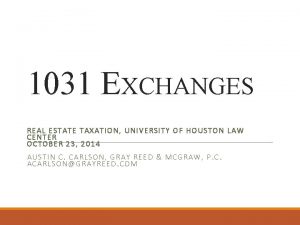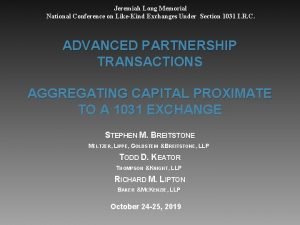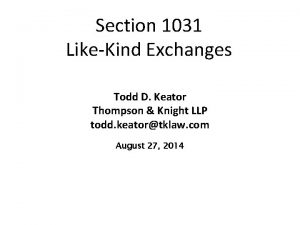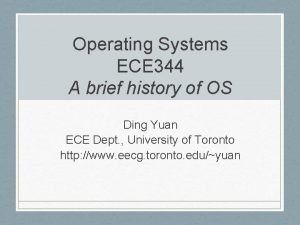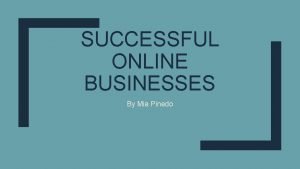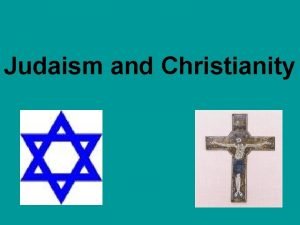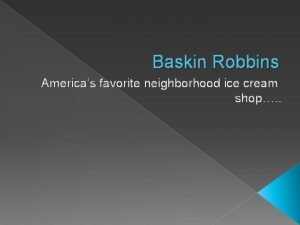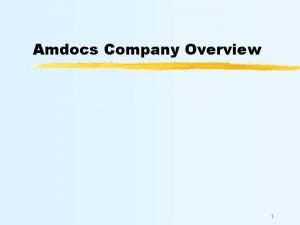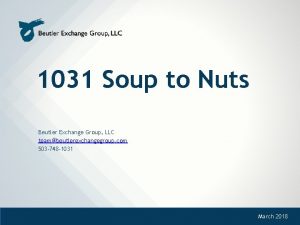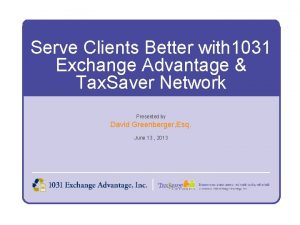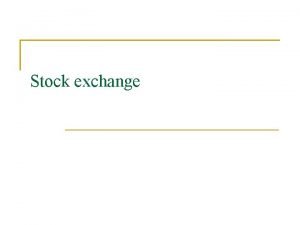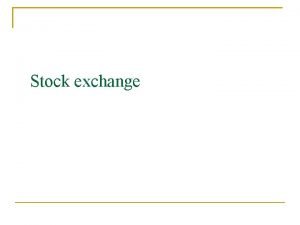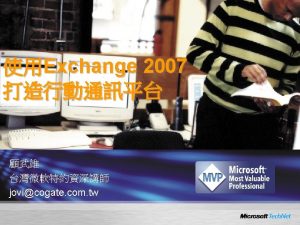1031 Exchange 1031 EXCHANGE AS APPLIES TO FOUNDERS













- Slides: 13

1031 Exchange 1031 EXCHANGE AS APPLIES TO FOUNDERS

In this presentation � What is 1031 Exchange? � Who is 1031 for? � When would you use 1031? � How a 1031 Exchange is accomplished. � A 1031 Exchange example. � 1031 Exchange Time Limit � About Qualified 1031 Intermediaries. � Founders opportunity. � Discussion

What is 1031 Exchange? A 1031 Exchange, also known as a Like Kind Exchange or Starker Tax Deferred Exchange (named for an investor who challenged and won a case against the IRS) is a transaction under United States law which specifies under section 1031 of the Internal Revenue Code, 26 U. S. C. § 1031 the following: "No gain or loss shall be recognized on the exchange of property held for productive use in a trade or business or for investment if such property is exchanged solely for property of like kind which is to be held either for productive use in a trade or business or for investment. "

Who is 1031 for? � 1031 is for Taxpayers to defer all of the capital gains taxes resulting from the sale of investment property. Must use a Qualified Intermediary (QI or Accommodator).

How 1031 is accomplished. 1. An investor decides to sell investment property and do a 1031 exchange. He contacts a qualified intermediary (QI) and they enter into an agreement. 2. The investment property is put on the market. 3. An offer to purchase the investment property is accepted and signed by the QI. 4. Escrow for the sale is opened, and a preliminary title report is produced. 5. The QI sends required exchange documents to the escrow closer for signing at property closing. 6. Escrow closes.

How 1031 is accomplished. (cont) 7. Within the first 45 days after the close of escrow on the sale of the relinquished property, the investor identifies replacement properties as required by law. This is known as the "Identification Period". The investor has three options concerning their decisions of the replacement property prospects necessary to be known by the QI. A. They may chose up to three replacement properties regardless of price. -200% Rule B. They may chose any number of properties as long as they DO NOT exceed an aggregate of 200% of value of the relinquished property. -95% Rule: C. The investor may also chose any number of prospective properties as long as they acquire 95% of them. 8. Within 180 days after the close of escrow on the sale of the relinquished property, the investor closes on one of the replacement properties which he has identified. This is called the "Exchange Period". This completes the exchange. No cash – or “boot’’, as it is known – is taken by the exchanger.

1031 exchange example An owner of a detached house on 3 acres is transferred by his employer to another state. Rather than selling the home, which will no longer be his personal residence, he chooses to rent it out for a period of time. After ten years, he decides that he wants to sell it but, at the same time, he has a grown son who will be going to college in yet another state. He decides that he wants to buy an apartment building in the college town for the son and other students to rent while they are in school. His house has appreciated from $200, 000 to $300, 000. Therefore, he arranges for an IRC 1031 Exchange, and buys the new property, thus avoiding the capital gain at that time.

1031 Exchange Time Limit In a 1031 Delayed Exchange the clock begins ticking when the relinquished property closes. All properties that will be used as replacement property for the exchange must be identified in writing before the end of the identification period, which is limited to 45 days. All replacement property purchases must be closed before the end of the exchange period, which is limited to 180 days. Frequently, the most difficult component of a 1031 exchange is identifying a replacement property within the first 45 days following the sale of the relinquished property. The IRS is strict in not allowing extensions.

About Qualified Intermediaries � A corporation that is in the full-time business of facilitating 1031 exchanges. The role of a QI is similar to, but not identical to, the role of an escrow company. � The Qualified Intermediary does not provide legal or specific tax advice to the exchanger, but will usually perform the following services: Coordinates with the exchangers and their advisors, to structure a successful exchange. Prepares the documentation for the Relinquished Property and the Replacement Property. Furnishes escrow company with instructions and documents to effect the exchange. Secures the funds in an insured bank account until the exchange is completed. Provides documents to transfer Replacement Property to the exchanger, and disburse exchange proceeds to escrow. Holds the document of Identification of Replacement Properties sent by the Taxpayer. Submits a full accounting of the Exchange Funds for the Taxpayers Records. Submits a 1099 to the Taxpayer and the IRS for any growth proceeds paid.

Founders Opportunity lies in the time limits 45 Day “Identification” time limit presents the greatest opportunity. The IRS is strict in not allowing extensions If Founders condos could be identified as a potential exchange property… 180 days to close Time limit. Replacement properties must be closed within 180 days Rapid close is not a problem for founders.

Things noted during research �Like Kind Exchange (1031 section h – Part 1) Real property located in the United States and real property located outside the United States are not property of a like kind. � Founders should not pitch non-US property for 1031 exchange. � 2 Years There are special IRS rules about property held for less than 2 years � It would be wise for Founders to consider an offering with 2 years of waved fees.

Next Step – Speak with QI’s � Out of State: While I fumble around learning the space I think it best to speak with people not on our doorstep. � Pose following questions. Is there anything (legally or ethically) which would prevent a QI from receiving a fee from a developer? Do your clients often have trouble identifying 3 potential exchange properties and if so would it be of benefit to them to be able to list a “sure sale” – just in case their first choice doesn’t work out? Do other developers contact you with “deals” such as I am trying to work out? – If so, what attributes of their offerings appeal most?

References and Links �Wikipedia �Federation of Exchange Accommodators �Discussion…
